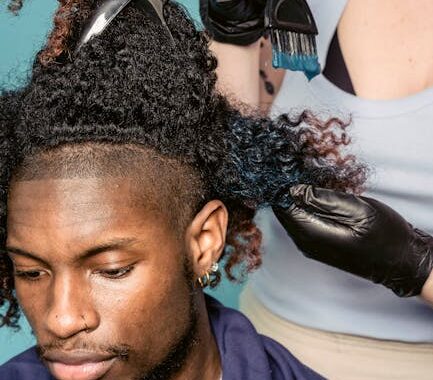The Ta-Ku Hairstyle: A Deep Dive into its Evolution, Variations, and Cultural Significance
The “Ta-Ku hairstyle,” while not a formally recognized term in mainstream hairdressing, refers to a distinctive style popularized by the Australian-born, Los Angeles-based musician Ta-Ku. Characterized by its textured, often slightly disheveled, yet meticulously styled appearance, the Ta-Ku hairstyle has become a significant trend, inspiring variations and interpretations across diverse communities. This article explores the origins, key features, and cultural implications of this increasingly popular look.
Understanding the Defining Features of the Ta-Ku Hairstyle
The Ta-Ku hairstyle isn’t defined by a single, rigid style but rather a collection of shared characteristics. It typically involves medium to long hair, styled with a textured, slightly undone finish. This effect is often achieved through various techniques, including the use of styling products to create volume and definition, careful layering, and strategic use of fades or undercuts. The overall aesthetic is one of effortless cool, a blend of sophistication and relaxed nonchalance. The exact style can vary greatly based on hair type and individual preferences, making it highly versatile. Whether it involves tight curls, loose waves, or straight hair, the common thread is a sense of natural texture and movement.
The Evolution of the Ta-Ku Hairstyle: From Inspiration to Influence
Tracing the precise origins of the Ta-Ku hairstyle is challenging. It didn’t emerge from a single salon or stylist but rather organically, drawing inspiration from various existing styles. Its popularity is largely attributed to Ta-Ku himself and his consistent showcasing of this style through his public appearances and social media presence. This visual representation, coupled with his growing influence in the music industry, propelled the look into the mainstream consciousness. The hairstyle’s evolution has seen variations, influenced by broader trends in men’s hairstyles, but the core elements of texture and carefully controlled imperfection have remained consistent.
Variations and Interpretations: Adapting the Ta-Ku Look
The beauty of the Ta-Ku hairstyle lies in its adaptability. While the core aesthetic remains relatively consistent, individual variations abound. Men with straight hair might achieve the look through strategic layering and the use of texturizing products. Those with curly or wavy hair can embrace their natural texture, enhancing it with styling creams or oils to create definition and control frizz. Furthermore, incorporating elements like fades on the sides or undercuts can add a modern twist, providing a contrast between the textured top and cleaner sides. The possibilities are virtually endless, offering a unique expression of personal style for each individual.
Hair Type and Styling Considerations for the Ta-Ku Hairstyle
- Straight Hair: Requires texturizing products and potentially layering to achieve the desired volume and movement.
- Wavy Hair: Naturally lends itself to the style, benefiting from products to enhance definition and reduce frizz.
- Curly Hair: Can create a striking, voluminous Ta-Ku hairstyle with the right styling techniques and products designed for curly hair.
The Cultural Significance of the Ta-Ku Hairstyle
The Ta-Ku hairstyle transcends simple aesthetics; it reflects broader cultural trends in masculinity and self-expression. Its popularity speaks to a shift away from rigidly defined hairstyles towards a more natural, individualistic approach. The slightly messy, unkempt look challenges traditional notions of perfectly groomed hair, embracing a sense of effortless cool and nonchalance. This aligns with a wider cultural movement towards celebrating individuality and embracing natural textures. The Ta-Ku hairstyle, therefore, can be seen as a reflection of these evolving cultural values.
Maintaining and Styling the Ta-Ku Hairstyle: A Practical Guide
Maintaining the Ta-Ku hairstyle requires the right tools and products. A quality hair dryer, texturizing sprays or creams, and possibly a styling balm or pomade are essential for achieving the desired texture and hold. Regular trims are crucial to maintain shape and prevent split ends. Understanding your hair type and choosing the right products to complement it is key to achieving optimal results. [See also: Related Article Titles on Hair Care]
The Ta-Ku Hairstyle and its Future: Ongoing Trends and Influences
Given the inherent versatility and adaptability of the Ta-Ku hairstyle, it’s likely to remain a popular choice for men seeking a stylish yet relatively low-maintenance look. As men’s fashion and hairdressing trends continue to evolve, we can expect further variations and interpretations to emerge. However, the core characteristics that have defined the Ta-Ku hairstyle—texture, movement, and a sense of controlled imperfection—are likely to persist, ensuring its continued relevance for years to come. The Ta-Ku hairstyle continues to evolve, reflecting broader cultural shifts and the ever-changing landscape of men’s fashion.
Conclusion: The Enduring Appeal of the Ta-Ku Hairstyle
The Ta-Ku hairstyle, while not a formally defined style, has undeniably made its mark on the world of men’s hairdressing. Its popularity stems from its versatility, adaptability, and alignment with contemporary trends in masculinity and self-expression. It’s a style that celebrates individuality and natural texture, offering a range of possibilities for men of all hair types. The enduring appeal of the Ta-Ku hairstyle lies in its effortless cool and its ability to be adapted and personalized, making it a timeless classic within the ever-evolving world of men’s hairstyles.


